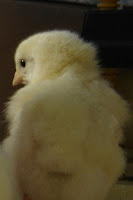It is always amazing to me just how quickly Cornish Cross chicks develop and grow. When they hatch, they are, for all intents and purposes, the same size as any "normal" sized chick. Bantams are smaller so I don't include them in the group. And within days, they are outsize their peers, and start to grow feathers on their wings. I have already needed to raise up the warmer because of height/growth. In about a week, I will need to put in the other brooder warmer because they will be too chunky to all fit under the one.
I can't remember if I indicated that we have no plans to get more layer chicks this year. We will deal with the hens that we have and will probably get more layer chicks next year. We did get nine meat chicks this spring since we are eating more chicken due to health/diet restrictions. Can't get any healthier chickens than the ones I raise myself. No hormones, antibiotics or other stuff added because we keep the environment clean and we raise our chicks as humanely as possible. That means that they get to go outside when mature enough and will get to act like chickens, even if they are a bit lazier than the layers.
For the photos, I tried to only use natural light (without flash) but that means that the speed of the picture (lens is open) longer to capture the image. Of course, these little guys are not inclined to just sit and wait for the photo. Out of 15 tries, this was all I could get with only a little blur.
For the photos, I tried to only use natural light (without flash) but that means that the speed of the picture (lens is open) longer to capture the image. Of course, these little guys are not inclined to just sit and wait for the photo. Out of 15 tries, this was all I could get with only a little blur.
We are supposed to get snow again this weekend. Brrrrrrrr.... Winter can't be over soon enough for my tastes. We have a space heater that blows some warm air into the small cage that we have covered with an old sheet to minimize drafts. Otherwise, it is simply too cold in the garage and the chicks will not get out from under the warmer to eat and drink (and poop). They are way too stinky to start out in the house.We had this issue last year too. The typical purchase time in the spring for Cornish X is April. But, if we wait for that time, then we tend to have to deal with the hot temps of June and July, which is stressful on them just prior to process time. I'm hopeful that they all survive through to next week.
 |
| You can't see me! |
 |
| Dinner Time |
 |
| Litte Fluff Balls Don't Hold Still |
 |
| So then he said. . . |





